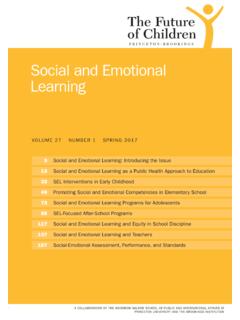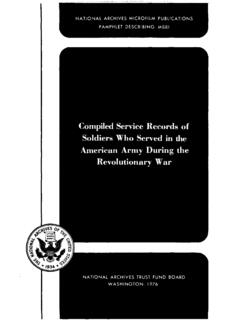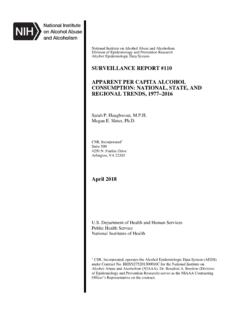Transcription of Charter Schools and the Achievement Gap - The Future of ...
1 Sarah CohodesCharter Schools andthe Achievement GapPOLICY ISSUE WINTER 2018 The Future of Children promotes effective policies and programs for children by providing timely, objective information based on the best available Future of Children would like to thank Cynthia King Vance for her generous Editorial StaffEditor-in-Chief Sara McLanahan Princeton University Director, Center for Research on Child Wellbeing, and William S. Tod Professor of Sociology and Public AffairsSenior EditorsJanet M. Currie Princeton University Director, Center for Health and Wellbeing; Chair, Department of Economics; and Henry Putnam Professor of Economics and Public AffairsRon Haskins Brookings Institution Senior Fellow, Cabot Family Chair, and Co-Director, Center on Children and Families and Public AffairsMelissa Kearney University of Maryland Professor, Department of EconomicsCecilia Elena Rouse Princeton University Dean, Woodrow Wilson school of Public and International Affairs, Katzman-Ernst Professor in the Economics of Education, and Professor of Economics and Public AffairsIsabel Sawhill Brookings Institution Senior FellowJournal StaffAssociate Editor Kris McDonald Princeton UniversityManaging Editor Jon Wallace Princeton UniversityOutreach Director Lisa Markman-Pithers Princeton University Associate Director.
2 Education Research SectionOutreach Coordinator Emily Bowden Brookings InstitutionCommunications Coordinator Regina Leidy Princeton UniversityAdministrator Tracy Merone Princeton UniversitySARAH COHODES | Charter Schools AND THE Achievement GAP 1 Charter Schools and the Achievement GapSarah CohodesSarah Cohodes is an assistant professor of education and public policy at Teachers College, Columbia thanks Benjamin Cosman and Marisa Morin for excellent research assistance. Work on this article was supported in part by the Upward Mobility Commission at the Yankelovich Center for Social Science Research at the University of California, San Diego. This article expands on material prepared for a report for the Barrow of the Federal Reserve Bank of Chicago reviewed and critiqued a draft of this ISSUE WINTER 2018 Charter Schools in the United StatesCharter Schools are public Schools that operate with autonomy from traditional school districts.
3 They are given flexibility in curriculum, structure of the school day and year, and budget management, and are not required to participate in collective bargaining. In exchange for this flexibility, charters are held accountable by their authorizers (state education agencies or organizations like colleges, special boards, or even school districts, depending on the state), who can revoke these Schools charters if they don t meet state standards. Charter Schools are free and open to the public. If more students wish to attend a Charter school than there are seats available, admission is by lottery. The first Charter Schools were created in Minnesota in 1993. Forty-three states and Washington, DC, now have laws that permit the operation of Charter Schools , and around 7,000 Charter Schools now serve more than 5 percent of students in the United They ve grown steadily over the past 10 years, adding about 300 or 400 Schools each year.
4 To put this in perspective, about 10 percent of US students attend a private school , and 3 percent are homeschooled. Despite the relatively small size of the Charter school sector, Charter Schools and their effects on students have been a large part of the education policy conversation in the past two decades. Though Charter Schools were originally envisioned as laboratories for testing educational practices, their proponents On average, Charter Schools perform at about the same level as traditional public Schools . But an overall estimate disguises considerable variation in Charter school impacts. Urban Charter Schools and those serving low-income and minority students, a number of which share a no excuses philosophy, tend to produce the largest gains.
5 Expanding these highly effective charters and their practices may be a way to close Achievement gaps. Research shows that charters can expand successfully and that traditional public Schools that adopt Charter practices (or are taken over by Charter operators) can also make large academic gains. But to have a meaningful impact on nationwide Achievement gaps, Charter school approaches would need to be adopted beyond the Charter sector itself. Any interventions that are built around using Charter Schools to close Achievement gaps should focus not on the type of school but on the practices that work in the most effective Charter Schools . 2 THE Future OF CHILDREN currently value them as an outlet for students and families who are dissatisfied with traditional public Additionally, advocates claim that increasing competition by allowing students to vote with their feet may improve systemwide Impact of Attending a Charter SchoolResearchers who wish to assess how attending a Charter school affects student Achievement face a common problem in social science research: selection bias.
6 You could simply compare the test scores of students in Charter Schools with those in traditional public Schools , but that would be misleading. Charter school students have chosen this alternative, and thus they may be different from their peers in traditional public Schools . If you saw differences in test scores between charters and traditional public Schools , you couldn t say whether they were caused by differences in schooling or by differences in the type of students who attend charters. It s not hard to imagine that students who choose to attend Charter Schools are different from those who don t. For example, their families were motivated to seek an educational opportunity for their children outside the norm.
7 Consequently, if Charter students had higher test scores, it may simply reflect the fact that they re the type of students who attend a Charter school , rather than saying anything about the school itself. Happily, many Charter Schools have a built-in mechanism to overcome the selection-bias problem. Because Charter Schools are required by law to admit students by a random lottery if they re oversubscribed, Charter school admissions are analogous to an experiment in which participants are randomly assigned to a treatment group or a control group (a randomized controlled trial). After accounting for important details that arise from operating a lottery in the real world versus doing so purely for research purposes, such as sibling preferences and late applicants, a random lottery assigns the seats for Charter Schools that are oversubscribed.
8 This allows researchers to compare the outcomes of a treatment group of students who were offered a seat in the lottery to a control group of those who were not. To estimate the effect of attending a Charter school (as opposed to applying to a Charter school ), researchers divide the treatment-control test score difference by the difference in attendance rates. The benefit of this approach is that the random lottery ensures that the two groups have similar observed and unobservable characteristics, and therefore any differences in outcomes can be attributed to attending a Charter school rather than to unobserved differences among the students. In short, this type of study is considered the best way to generate causal estimates of program effects.
9 Wherever possible, this review focuses on evidence generated by lottery-based studies. The lottery approach has a major downside, however. It is possible to estimate a lottery effect only when a school is oversubscribed and has student records available. Thus, findings based on lottery results may not generalize to the entire population of Charter Schools . And it s reasonable to believe that oversubscribed Schools are more successful than other Charter Schools . Indeed, evidence from Boston supports this To estimate the effect of attending a Charter school that isn t oversubscribed or doesn t have sufficient or accessible lottery records, researchers typically attempt to control for differences between Charter and noncharter students with some form of statistical matching, in what is often referred to as an observational study.
10 Matching studies find pairs or groups of students who differ only by Charter school attendance and then compare outcomes between Charter and noncharter students within these pairs or groups. So, for example, a matching study might find two girls in fourth grade in the same school who are both Latina English-language learners who don t receive special education services and have similar test scores. In sixth grade, one attends a Charter school and the other doesn t. The difference in their sixth-grade scores would contribute to the overall estimate of a Charter school effect, which would be averaged over all such pairs. This observational approach can give estimates for a much larger group of Charter Schools , but it may not entirely purge those estimates of selection bias because the students who make up the matched groups may differ in unobservable ways.










